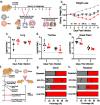This is a preprint.
Nucleocapsid mutations in SARS-CoV-2 augment replication and pathogenesis
- PMID: 34671771
- PMCID: PMC8528077
- DOI: 10.1101/2021.10.14.464390
Nucleocapsid mutations in SARS-CoV-2 augment replication and pathogenesis
Update in
-
Nucleocapsid mutations in SARS-CoV-2 augment replication and pathogenesis.PLoS Pathog. 2022 Jun 21;18(6):e1010627. doi: 10.1371/journal.ppat.1010627. eCollection 2022 Jun. PLoS Pathog. 2022. PMID: 35728038 Free PMC article.
Abstract
While SARS-CoV-2 continues to adapt for human infection and transmission, genetic variation outside of the spike gene remains largely unexplored. This study investigates a highly variable region at residues 203-205 in the SARS-CoV-2 nucleocapsid protein. Recreating a mutation found in the alpha and omicron variants in an early pandemic (WA-1) background, we find that the R203K+G204R mutation is sufficient to enhance replication, fitness, and pathogenesis of SARS-CoV-2. The R203K+G204R mutant corresponds with increased viral RNA and protein both in vitro and in vivo . Importantly, the R203K+G204R mutation increases nucleocapsid phosphorylation and confers resistance to inhibition of the GSK-3 kinase, providing a molecular basis for increased virus replication. Notably, analogous alanine substitutions at positions 203+204 also increase SARS-CoV-2 replication and augment phosphorylation, suggesting that infection is enhanced through ablation of the ancestral 'RG' motif. Overall, these results demonstrate that variant mutations outside spike are key components in SARS-CoV-2's continued adaptation to human infection.
Author summary: Since its emergence, SARS-CoV-2 has continued to adapt for human infection resulting in the emergence of variants with unique genetic profiles. Most studies of genetic variation have focused on spike, the target of currently available vaccines, leaving the importance of variation elsewhere understudied. Here, we characterize a highly variable motif at residues 203-205 in nucleocapsid. Recreating the prominent nucleocapsid R203K+G204R mutation in an early pandemic background, we show that this mutation is alone sufficient to enhance SARS-CoV-2 replication and pathogenesis. We also link augmentation of SARS-CoV-2 infection by the R203K+G204R mutation to its modulation of nucleocapsid phosphorylation. Finally, we characterize an analogous alanine double substitution at positions 203-204. This mutant was found to mimic R203K+G204R, suggesting augmentation of infection occurs by disrupting the ancestral sequence. Together, our findings illustrate that mutations outside of spike are key components of SARS-CoV-2's adaptation to human infection.
Figures





References
-
- International Monetary Fund Research Dept. World Economic Outlook, April 2020 : The Great Lockdown. Paper. International Monetary Fund, Dept. R; 2020. April 14, 2020.
-
- Word Health Organization. Coronavirus disease (COVID-19) pandemic. 2021;2021(29 September).
-
- Word Health Organization. Tracking SARS-CoV-2 variants. 2022;2022(17 February).
Publication types
Grants and funding
LinkOut - more resources
Full Text Sources
Miscellaneous
